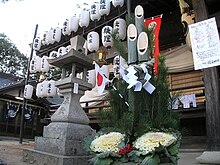Kadomatsu
| Look up kadomatsu in Wiktionary, the free dictionary. |
This article needs additional citations for verification. (November 2015) |

A kadomatsu (門松, "gate pine") is a traditional Japanese decoration as yorishiro of the New Year placed in pairs in front of homes to welcome ancestral spirits or kami of the harvest.[1]
They are placed after Christmas until January 7 (or January 15 during the Edo period) and are considered temporary housing (shintai) for kami. Designs for kadomatsu vary depending on region but are typically made of pine, bamboo, and sometimes ume tree sprigs which represent longevity, prosperity and steadfastness, respectively.[2] "The fundamental function of the New Year ceremonies is to honor and receive the toshigami (deity), who will then bring a bountiful harvest for farmers and bestow the ancestors' blessing on everyone." After January 15 (or in many instances the 19th) the kadomatsu is burned to appease the kami or toshigami and release them.
The kadomatsu is included in Unicode as U+1F38D
